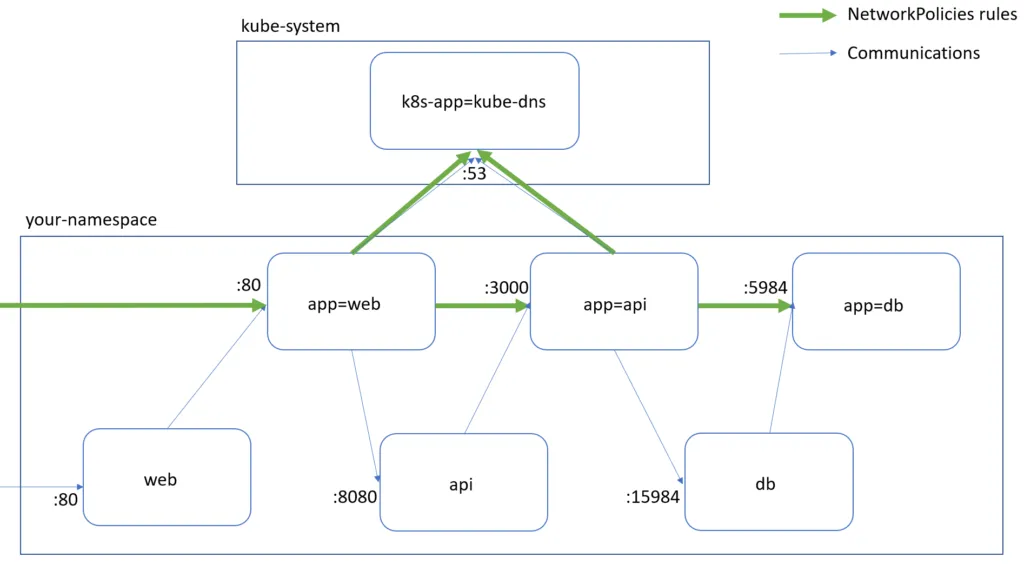
Hyperlight: Achieving 0.0009-second micro-VM execution time
In this post, we’ll take the demo application and show how it…

In May 2019, Network Policies on Azure Kubernetes Service (AKS) became generally available through the Azure native policy plug-in or through the community project Calico. This user-defined network policy feature enables secure network segmentation within Kubernetes and allows cluster operators to control which pods can communicate with each other and resources outside the cluster.
In this tutorial, we’ll practice building four different Network Policies:
For additional background, I encourage reading the article Integrating Azure CNI and Calico: A technical deep dive, where you’ll see all the key concepts explained from a networking perspective with AKS. Furthermore, here is a Kubernetes tutorial, Calico tutorial and AKS tutorial to help you get started.
Some things to keep in mind before you jump into the tutorial:

Let’s do it!
First, we need to provision an AKS cluster with Network Policies enabled, for the purpose of this demo below, we will use Calico:
az aks create... --network-policy calico
To start and illustrate this we need to deploy those Pods and Services:
ns=yournamespace
kubectl create ns $ns
kubectl config set-context --current --namespace $namespace
kubectl apply -f https://raw.githubusercontent.com/mathieu-benoit/k8s-netpol/master/db-api-web-deployments.yaml
You now have three Pods and three Services:
kubectl get pod,svc
We could check that WEB is publicly accessible (you may need to wait for few seconds to get the Public IP provisioned):
curl $(kubectl get svc web -o jsonpath='{.status.loadBalancer.ingress[0].ip}')
Our first test is to see that any pods could communicate with others even externally, let’s run few successful commands:
kubectl run curl-$RANDOM --image=radial/busyboxplus:curl --rm -it --generator=run-pod/v1
# curl https://kubernetes.io
# curl http://db:15984
# exit
Let’s apply the first important Network Policy, Deny all ingress and egress!
kubectl apply -f https://raw.githubusercontent.com/mathieu-benoit/k8s-netpol/master/deny-all-netpol.yaml
We can check that WEB isn’t publicly accessible anymore:
curl --connect-timeout 2 $(kubectl get svc web -o jsonpath='{.status.loadBalancer.ingress[0].ip}')
Let’s also rerun the two previous tests, which should fail now:
kubectl run curl-$RANDOM --image=radial/busyboxplus:curl --rm -it --generator=run-pod/v1
# curl --connect-timeout 2 https://kubernetes.io
# curl --connect-timeout 2 http://db:15984
# exit
Actually, no one could communicate from/to that namespace at this stage, that’s what we want. Now, let’s be more granular and illustrate the “Least Access” and “Just Enough Access” Security Principles.
First, DB is accessible only from API on port 5984 and doesn’t have access to anything:
kubectl apply -f https://raw.githubusercontent.com/mathieu-benoit/k8s-netpol/master/db-netpol.yaml
Let’s validate that DB doesn’t have access to anything:
kubectl run curl-$RANDOM --image=radial/busyboxplus:curl --labels app=db --rm -it --generator=run-pod/v1
# curl --connect-timeout 2 http://web:80
# curl --connect-timeout 2 https://kubernetes.io
# exit
Now, API has only access to DB on port 5984 and is accessible only from WEB on port 3000:
kubectl apply -f https://raw.githubusercontent.com/mathieu-benoit/k8s-netpol/master/api-netpol.yaml
Actually, we also need to do an extra action here by adding a Label on the kube-system Namespace (NetworkPolicies are all about Labels):
kubectl label ns kube-system name=kube-system
Let’s validate that API has access to DB, but doesn’t have access to WEB or Internet:
kubectl run curl-$RANDOM --image=radial/busyboxplus:curl --labels app=api --rm -it --generator=run-pod/v1
# curl http://db:15984
# curl --connect-timeout 2 http://web:80
# curl --connect-timeout 2 https://kubernetes.io
# exit
Finally, WEB only has access to API on port 3000 and is only accessible from the Internet on port 80:
kubectl apply -f https://raw.githubusercontent.com/mathieu-benoit/k8s-netpol/master/web-netpol.yaml
Let’s validate that WEB has access to API, but doesn’t have access to DB or Internet:
kubectl run curl-$RANDOM --image=radial/busyboxplus:curl --labels app=web --rm -it --generator=run-pod/v1
# curl http://api:8080
# curl --connect-timeout 2 https://kubernetes.io
# curl --connect-timeout 2 http://db:15984
# exit
We could check that WEB is publicly accessible again:
curl $(kubectl get svc web -o jsonpath='{.status.loadBalancer.ingress[0].ip}')
Here we are! We have secured communications for our three Pods: WEB, API, and DB by defining the very strict minimal requirements, nothing less and nothing more.
Some gotchas:
Labels on Pods and NamespacesServices , nor the ports exposed there, it’s about Pods‘ portspodSelector and namespaceSelectorNamespace, but via the namespaceSelector for Ingress or Egress you could reference external Namespaces. You could use GlobalNetworkPolicy with Calico to apply rules across NamespacesPod via its Service name exposure you need to add an Egress rule for the DNS resolver (with the label k8s-app=kube-dns) in the kube-system Namespace. We saw that we need to add a label name=kube-system on the kube-system Namespace.policyTypes: sectionResources:
Hope you enjoyed this blog article and the associated resources and are able to leverage this as a part of your own Security posture with Kubernetes.
Questions or comments, please let me know in the comments below. Cheers!